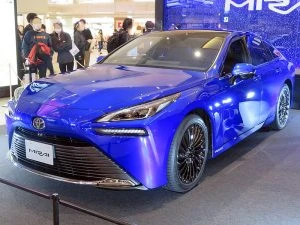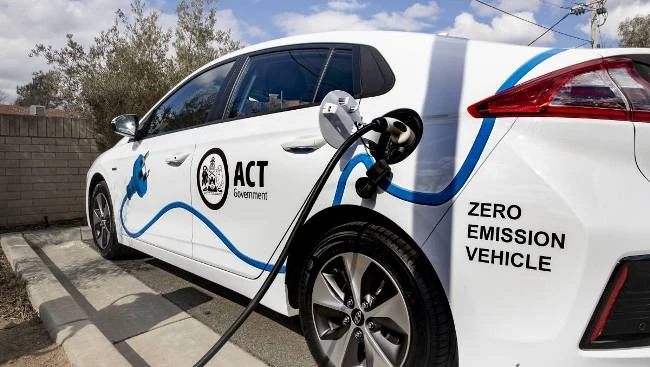Environment
Japan’s Automotive Brilliance

Tokyo, Japan
You can’t go anywhere around Australia without noticing just how many Japanese made vehicles are motoring around our roads (and off them). Since the 1960s, Japan has been among the top 3 automotive manufacturers in the world. The country is home to a number of motor companies, and you’ll be familiar with them: Toyota, Honda, Nissan, Mitsubishi, Suzuki, Subaru, Isuzu. There are, of course, more than these mainstream manufacturers. Japan has around 78 car-manufacturing factories in 22 regions, and these employ over 5.5 million people (more than the entire population of New Zealand).
The strong competition that is happening on a global scale in the automotive industry has forced the manufacturers to come up with a new model design every four to five years. Along with the new models, new innovative designs and new technologies are presented and used by the automakers in their new vehicles. Automotive manufacturing is the prominent manufacturing type in Japan, which takes up 89% of the country’s manufacturing sector. A large amount of time and money are invested into developing and improving the automotive manufacturing process, which, in turn, increases the quality and efficiency of their manufactured automotive products.
Some of the brilliant new developments from Japan automobile manufacturers have led to distinct and innovative new designs for current and future automobiles. In order to control the market dependency on fuels, and in order to design vehicles that are more fuel-efficient, Japanese automakers have invested and built hybrid vehicles and fuel-cell vehicles.
The ideology and popularity of environmentally friendly vehicles is creating a wave of global interest and demand for these sorts of vehicles. More and more automakers around the globe are focusing on creating the types of vehicles that are friendlier on the environment to their production line. Japan’s automotive manufacturers are leaders in this field. Japanese innovations in these technology sectors include autonomous taxi services and airport transportation, high-definition maps and open-source software modules for autonomous vehicles, advanced hydrogen fuel cell and alternating-current battery technology, and silicon carbide (SiC) semiconductor films for EV power electronics. Japanese companies have been developing hydrogen fuel cell technology, which is projected to reach a market size of approximately $43 billion by 2026, growing at a CAGR of 66.9% from 2019 to 2026. Japan’s prowess in creating autonomous vehicles and their resulting cutting edge safety features puts them well ahead of the game.
An electric vehicle is an automobile that produces power from electrical energy stored in batteries instead of from the burning of fossil fuels. Top automakers such as Toyota, Honda, and Nissan are already class leaders.
Hybrid vehicles use two or more distinct power sources to move the car. Typically, electric motors combine with traditional internal combustion engines to produce power. Hybrid vehicles are highly fuel efficient. Again, Japan’s Toyota motor company is one of the automotive industry leaders in hybrid vehicle research and production – with the Toyota Prius model leading the way. Hybrid variants are available on many of Toyota’s collection of new vehicles.
A Fuel Cell Vehicle is equipped with a “Fuel Cell” in which electricity is generated through the chemical reaction between hydrogen and oxygen. This chemical reaction provides the source of power to the motor. Fuel cell systems operate by compressing hydrogen made from natural gas and gasoline, which is then converted to hydrogen by on-board systems. Toyota’s latest fuel cell vehicle, the Mirai II, is sold in Japan. The Mirai II uses a Hydrogen Electrochemical fuel cell that creates 130 kW. The electric motor that is powered by the fuel cell produces 136 kW and 300 Nm. It’s very stylish, too.

Toyota Mirai II
Driving the Hours of Darkness

One of my favourite times for driving is at night or in the early morning; and by early morning I mean well before ‘sparrow’s fart’. The roads are mostly empty and everything is quiet and serene. It is possible to travel during the hours of darkness and quite quickly cover the ground. Here are some definite advantages of travelling by night, with a few of the disadvantages thrown in as well.
First of all there is nothing quite like the fresh, cool air that you get during nightfall. A lot of the wildlife has settled for the night and the night air has a pristine smell that I love. When you get out and stretch and take a break during the night drive, the air is always satisfying and refreshing – but just as long as it’s not a frog strangling gulley washer! You can hear the silence with only the odd chirp or bark, squeak or rustle of wind filling the air. Just after midnight, the roads are mostly empty and it can be an ideal time to drive. You will get the odd long haul truck unit doing the intercity run, but on the whole, I find driving at night to be pretty relaxing.
Who doesn’t like getting places faster? At night, driving with very few other vehicles on the road means that you can keep up a steadier speed at higher velocity which allows you to cover the ground in a shorter amount of time. You can hit the speed limit and stay at it for longer. This is a win-win because it also links in with fuel efficiency, which I’ll touch on later.
Not having the sun about means the night air is cooler, which is a phenomenon that’s rather nice in a hot sunny country by-day – like it is in Australia. Your air-conditioning requirements are not quite so demanding, therefore avoiding the need to pump through gallons of cool fresh air at maximum levels in order to keep cool inside the car. You also have less heat streaming in through the closed windows and onto your skin, another nice feature about night driving. Sun strike is not a problem, either.
If you are getting from A to B quicker at night, then it is obvious that the lack of traffic will mean that the drive will be more fuel efficient. Because there are fewer cars on the road, your speed is even and you avoid the stop and go motion of other cars around you. There actions and choices slow you down, and the more of these the slower you go as they the weave in and out of your lane and generally make life more stressful. Because you’re avoiding other cars by travelling at night, you are going to get better fuel efficiency. A steady higher speed is good for economy. Putting a lighter load on the air-conditioning system by driving at night in the cooler air is also good for fuel economy. More economic, cooler, more relaxed, quicker and more fuel efficient at night: now who doesn’t like that?
When you do need to refuel at a gas station, getting fuel at night is a breeze, with nobody around other than the sleepy cashier. And there are even no cashiers at card-only fuel stations.
As with most things, there can be a downside to night driving. Yes, you could get sleepy when driving during the hours that you’re normally in bed. Not many shops open; and should you want to stop for a sleep, then most motels are closed up by 9/10 pm. Kangaroos and other larger creatures still wander, shuffle or bounce onto the road from seemingly out of nowhere in the dark. They can even do this in daylight, mind you…
Driving at night is/or can be fun and enjoyable. I personally enjoy it but realise that it’s not for everyone. After I have done a long haul at night, I do tend to take things pretty cruisy the next day, while ensuring I get a great night’s sleep the following night. I sense a few roadies coming on; it is the festive season, after all.
BEV & E-GMP Are The Way Forward: Hyundai.
In a major step forward in the electric car industry, Hyundai Motor Group has unveiled its new Electric-Global Modular Platform or E-GMP. It will produce a BEV or Battery Electric Vehicle in a dedicated move to create a core platform to develop the technology. To be launched in 2021, the program will form the basis for Hyundai’s next Ioniq, a dedicated BEV from Kia, and potentially other models for the brands. E-GMP is intended to be a bespoke platform for the company’s BEV range, having benefits such as increased development flexibility, powerful driving performance, increased driving range, strengthened safety features, and more interior space for occupants and luggage.
To be launched in 2021, the program will form the basis for Hyundai’s next Ioniq, a dedicated BEV from Kia, and potentially other models for the brands. E-GMP is intended to be a bespoke platform for the company’s BEV range, having benefits such as increased development flexibility, powerful driving performance, increased driving range, strengthened safety features, and more interior space for occupants and luggage.
Driving performance will allow a sport-oriented model to achieve sub-four second 100kph times, whilst the platform can accommodate SUVs, sedans, or Crossover Urban Vehicles. By using a system called modularisation, it makes for better building and cost amortisation. The chassis design can be shrunk or stretched to accommodate the battery placement and therefore ensure weight distribution is always as appropriate as possible. A five-link rear suspension system, which is typically used for mid and large sized vehicle segments, and the world’s first integrated drive axle (IDA), which combines wheel bearings with the drive shaft to transmit power to the wheels, enhance ride comfort and handling stability.
The structure will be ultra-high strength steel for rigidity, with hot-stamped steel parts adding to the torsional strength. Energy absorption can then be designed into the structure as needed. This includes the front of the chassis where the A-pillar can deform to spread energy from an impact and thereby diverting kinetic energy from the floor mounted battery and front engine.
Short overhangs maximise interior packaging, and assisted by the flat battery floor, means any vehicle can be tweaked to suit a specific use target. this could include seating layout and positioning for leg room.
Drive will come from an integrated, single module, unit, which is able to raise the rotational speed by up to 70% over existing units. The module is comprised of a motor, EV transmission, and an inverter. A smaller size means less weight and yet efficiency isn’t compromised.
“Today our front-wheel driven Hyundai and Kia BEVs are already among the most efficient ones in their segments.” said Albert Biermann, President and Head of R&D Division for Hyundai Motor Group. “With our rear-wheel driven based E-GMP, we are extending our technological leadership into segments where customers demand excellent driving dynamics and outstanding efficiency.”
Fayez Abdul Rahman, Senior Vice President of Vehicle Architecture Development Center for Hyundai Motor Group: “E-GMP is the culmination of years of research and development and brings together our most cutting-edge technologies. Our BEV line-up will evolve and be strengthened by this innovative new platform.”
Extra cooling has allowed Hyundai to redevelop their battery system. It is denser and more compact, with up to 10% more density in comparison to what is currently available. Linked to the engine unit is the inverter power module that uses Silicon Carbide material. This enhances efficiency by two to three percent and then allow a range extension from that battery of up to 5%. The battery module itself will be a standardised model, with a pouch-type cell structure that can be tailored as per design specification.
Drive itself will be predominantly rear wheel oriented. All wheel drive configuration on the E-GMP platform will be available. Hyundai will employ a EV transmission disconnector that “talks” to the front motor if fitted, and can switch, on the fly, between two and all wheel drive. As charge point infrastructure changes, Hyundai has future-proofed with an investment in a European based network, IONITY. The name also fits the IONIQ branding for Hyundai’s current EV range. IONITY currently offer 308 high power charge points that can charge at up to 350kW. There are 51 extra stations under construction with a view to offering 400 points by 2022.
As charge point infrastructure changes, Hyundai has future-proofed with an investment in a European based network, IONITY. The name also fits the IONIQ branding for Hyundai’s current EV range. IONITY currently offer 308 high power charge points that can charge at up to 350kW. There are 51 extra stations under construction with a view to offering 400 points by 2022.
E-GMP bring some forward looking tech. Charging at 800V is standard, with a switch to 400V available if necessary. The system has a patent on the technology as there are no additional equipment requirements to “step down” or “step up” the charge. A fully charged battery can provide over 500km of range, and can charge to 80% in just 18 minutes and in five minutes provide up to 100km of range.
There is also a new ICCU, or Integrated Charging Control Unit. This brings what is called V2L, or Vehicle To Load. Instead of a single path, being from a charge source to the BEV, a E-GMP vehicle can discharge to another electricity requiring source from 110V to 220V including another EV. Maximum output is rated as 3.5kW which Hyundai says could power a 55-inch TV for up to 24 hours.
Sibling company Kia is also part of the program, employing its “Plan S” strategy. One key aim is 20% of their vehicles to be EV in sales by 2025 and they are aiming to have seven dedicated BEVs by 2027.
Low Voltage: The Charge To EV Vehicles
With world governments declaring a transition to electric vehicles over the next three decades or earlier, such as the U.K. by 2030 or 2035, it would be reasonable to presume that Australian governments would also back any push, without extra roadblocks, to have EVs the primary vehicle for passenger transportation.
The Australian Capital Territory has gone to that length, as has the state government of Tasmania, with the Apple Isle declaring the government’s fleet will be 100% electric by 2030. the A.C.T. began their transition process in 2018 . Neither the A.C.T. or the Tasmanian government have currently declared that any form of EV tax will be implemented.
However, South Australia, New South Wales, and Victoria have all announced that the users of an EV will be subjected to a user tax. Victoria has declared that as soon as July 1, 2021, a road user tax on EVs will be implemented. Tony Weber, from the Federal Chamber of Automotive Industries, isn’t impressed:
“Australian state governments want to kill the technology at its infancy. Is this because some states want to substitute the Commonwealth excise tax with their own tax? Are motorists being caught in a petty game in which the states want to establish a new revenue base at the expense of the Commonwealth?”
Weber also points out the disassociation of the governments here in regards to what other nations are doing in respect to development alternatives for public vehicle transport.
“All around the world, global automotive companies have invested billions of dollars to develop environmentally friendly vehicles. And all around the world, progressive governments have supported the introduction of these vehicles. But here in Australia, we inhibit their introduction by levying extra charges on them. It simply beggars belief at this early stage of electric vehicle introduction.”
Mr Weber’s points take aim at the short-sighted attitude of the Australian states that appear to prefer revenue over doing something that reduces exhaust emissions and going some way to reduce the effects of climate change. “With its proposal to tax LZEVs through a road-user charging tariff, South Australia is discouraging the uptake of environmentally friendly motoring and is turning its back on the topic of Climate Change.”
The argument for the taxes comes from those that see that by using no petrol or diesel, which have excises attached, by using the same roads without those excise contributions, EVs are effectively getting a free ride. This overlooks the charges by electricity suppliers to any location providing an outlet for an EV to be charged, however then it’s pointed out those EV charges don’t go back into the roads.
This is something the Australian Automobile Association has in mind when it comes to a fairer apportioning of charges: “As people move towards electric vehicles and other low emission technologies, revenue from fuel excise is declining, which not only risks road funding, but also means some drivers are paying for roads while others are not, which is neither a fair nor a sustainable model. A nationally consistent approach will be important to drivers, who won’t want a patchwork of unique state charging systems, technologies, or rates.”

Regardless of which, it would appear to be a prudent move by the governments to look at what the A.C.T. is doing: Zero stamp duty on new zero emissions vehicles; 20% discount on registration fees; Annual savings from reduced running costs; Help to reduce greenhouse gas emissions and keep our environment clean and healthy; Quieter driving and reduced noise pollution.
And perhaps: In 2017 the United Kingdom and France announced their intention to ban the sale of new petrol and diesel cars by 2040, with all cars to be fully electric. Since this time, other countries have also committed to phasing out new petrol and diesel car sales including Scotland, India, China, Norway and the Netherlands.
Then there is the announcement in mid November, 2020, by General Motors, here.
As Bob Dylan once sang: the times, they are a-changing…but it seems some governments are stuck in time.